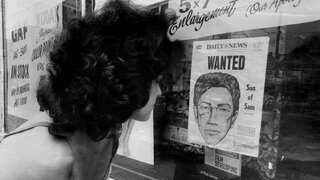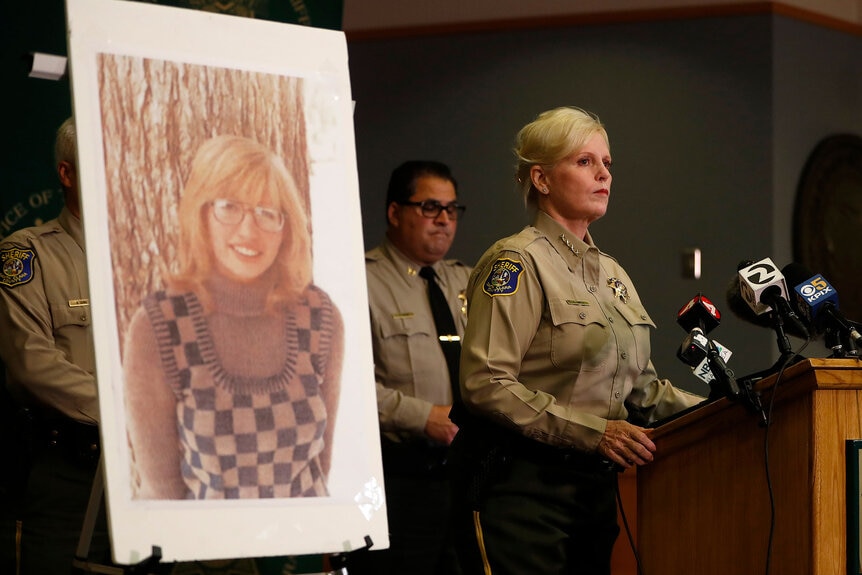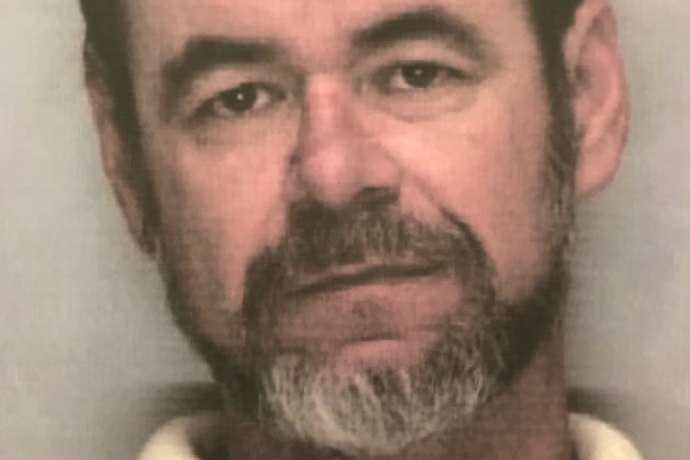How Is The Murder Of Arlis Perry Connected To The 'Son Of Sam' Case?
Arlis Perry, a 19-year-old newlywed, was found brutally murdered inside a Stanford University church on Oct. 13, 1974 and David Berkowitz once claimed to have known who killed her.

Warning: The following story contains an account of a sexual assault and murder that may be disturbing.
Nearly two years before the "Son of Sam" killings terrorized the streets of New York, another eerie killing took place on the other side of the country.
Arlis Perry, a 19-year-old newlywed, was found on Oct. 13, 1974 inside the Memorial Church on the Stanford University campus laying spread-eagle near the church altar, naked from the waist down with an ice pick shoved into her brain.
She had been sexually assaulted with a long five-foot church candle. Another candle had been shoved through her blouse up to the side of her neck, according to law enforcement accounts in the new Netflix docuseries “The Sons of Sam: A Descent Into Darkness.”
Perry also had wounds on her neck suggesting an attempted strangulation before the ice pick was driven into her brain, Palo Alto Online reports.
“I could not believe what I was seeing,” Raoul Niemeyer, a retired captain with the Stanford Department of Public Safety recalled in the docuseries. “I had a few homicides in my day but I had never seen anything so eerie.”
The heinous killing seemed as if somebody was “trying to make a point here” and send a message by the way the body had been posed.
“The things that were done to defile this woman were just unbelievable,” Niemeyer said.
For decades, the case remained unsolved and was once ominously mentioned by “Son of Sam” killer David Berkowitz, who suggested in messages to authorities that Perry had died at the hands of a Satanic cult.
The teen’s killer would remain a mystery for more than four decades until 2018, when DNA from the crime scene finally helped investigators find the suspected killer.
Seeking Refuge At Church
Perry disappeared on Oct. 12, 1974 after an argument with her husband of just two months, Bruce Perry.
The pair had reportedly been walking to the mailbox around 11:30 p.m. that night when they got into a fight about checking the tire pressure in their car, according to The Mercury News.
Perry—a deeply religious person who had recently moved to California from Bismarck, North Dakota—told her husband she wanted to go pray at the church and set off for the iconic landmark on the college campus.
When she hadn’t returned by 3:30 a.m. to their home in Quillen Hall, Bruce called police. The officers went to the church to check on Perry, but they found the doors were locked.
Security guard Stephen Blake Crawford told investigators that he had locked the church doors not long before midnight and had done another sweep of the church around 2 a.m. but never noticed anything unusual, according to Palo Alto Online.
Just hours later, at 5:40 a.m. Crawford told investigators he had stumbled upon Perry’s body and called police.
“Hey, we’ve got a stiff here,” he allegedly said, according to a lecture once given by former San Jose Mercury News columnist Scott Herhold.
Ken Kahn, a retired detective with Santa Clara Police Department, told producers of the docuseries that police theorized the 19-year-old had gotten locked into the church with her killer.
“He snuck up behind her, murdered her and then broke out the side door,” Kahn said.
Investigators were immediately struck by the disturbing details surrounding the case: she had carefully been posed in a place of worship, violated, and left in plain view to be discovered.
“After the murder was discovered, the dean of the chapel was brought in and he saw the scene,” Kahn said. “The first impression was ‘Well, this must be the work of the devil.’”
While Perry's husband was initially considered a suspect, he was later ruled out passing a polygraph.
Semen and a partial palm print on one of the candles was found at the scene of the crime, but the print wasn’t enough to link it to either Bruce or Crawford, and the case stalled out until a sheriff’s deputy in North Dakota received an ominous package from Berkowitz—who was behind bars for a string of murders in New York beginning in 1976.
“Son of Sam” Murders
Berkowitz had confessed to a killing six and wounding several others in a series of grisly murders on the streets of New York City beginning in 1976.
After his arrest in August 1977, he initially told police he had been instructed to kill by his neighbor Sam Carr’s black Labrador, Harvey; he pleaded guilty in 1978 to the string of murders attributed to the “Son of Sam” killer, loudly exclaiming in court that his mission during the nighttime prowls had been “to kill somebody!” according to a 1978 article in The New York Times.
But Berkowitz would later tell investigative journalist Maury Terry, who became convinced Berkowitz didn't act alone in the killings, that he had been part of a Satanic cult—with members allegedly including Carr’s real sons John and Michael Carr—who had carried out the killings collectively because they wanted to bring chaos to the world, according to the docuseries.
When John Carr was found shot to death under mysterious circumstances just six months later in rural Minot, North Dakota, investigators there also uncovered witnesses who suggested not only that Berkowitz and John Carr knew each other but that they were involved in the occult.
“These people said that John was the leader of the group, that John performed rituals numerous times. We know of one case where John killed a German Shepherd dog right back out here behind the building … and they were drinking blood,” Lt. Terry Gardner, a deputy sheriff in Ward County, North Dakota, said in an interview from the time that was re-aired in the docu-series.
Gardner told The New York Times in 1979 that he had “no doubt” based on the interviews he had conducted that John Carr and Berkowitz “knew each other well.”
A Link To The Arlis Perry Case?
Speculation about the possible involvement of a Satanic group was fueled when Gardner got a package from Berkowitz, who sent some literature, a picture of a person participating in devil worship and a book called the Anatomy of Witchcraft.
But it was what was inside the book, a message hand scrawled along the margins that read “Arlis Perry, hunted, stalked and slain. Followed to California” and “Stanford Univ.” that would lead some to believe Perry’s death may have been linked to the occult.
“There had been a rumor in Bismarck, shortly after Arlis had died, there was allegedly a cult there and she had gone with a friend to try to convert these people to Christianity,” Kahn said in an earlier interview included in the docuseries.
According to Neimeyer, there was speculation that Perry may have seen something she wasn’t supposed to know during her attempt to convert the members and they had followed her to California and killed her.
“But without any specific information, where were we going to go with it?” he said.
Then in 1981, Kahn said he got a letter from Berkowitz indicating that he might have some information about Perry’s death. He claimed that he had attended a cult meeting in Queens and someone got up during the meeting and had claimed to have killed her.
“So, off we go to New York,” Kahn said of investigators' attempt to substantiate the claims.
But when they arrived at the prison, Berkowitz never revealed the supposed killer’s identity.
“We thought we were getting close to him naming somebody but he abruptly says ‘If I am talking to you guys any longer, they are going to think I am a snitch,’” Kahn said in “The Sons of Sam: A Descent Into Darkness.” “I was advised there had been an attempt on his life in Attica. Somebody cut his throat. There was a nasty scar on his neck and then he said ‘Well, if I tell you the name, they’ll kill my father.’”
Investigators left empty-handed and concluded that Berkowitz didn’t really know anything about the case and was “just kind of jerking us around.”
A Suspected Killer Is Revealed
The case remained cold for decades until investigators uncovered new evidence in 2018 linking Crawford—the security guard on duty at the church—to the murder.
Crawford, at the time 72, shot himself in the head as police closed in on his San Jose apartment, according to The Mercury News.
“It’s been frustrating through the years that we could never get enough evidence to charge the suspect,” Santa Clara County Sheriff Laurie Smith said, according to the outlet. “It’s difficult for her family and it’s difficult for our department, but we finally have closure on this case.”
They were able to link Crawford, who had long been considered a person of interest in the case, to the crime through DNA that had been left on Perry’s clothing, Palo Alto Online reports.
The U.S. Air Force veteran had begun to work at the Stanford Department of Public Safety in 1971 but he was later offered a position as a security guard after a new police chief opted to restructure the department the following year.
"He complained bitterly about it. He told friends he did not like what they were doing to him," said Herhold, who attended the press conference to announce his death, adding that after the demotion he began to steal things from offices throughout campus.
He believed the 19-year-old was killed because of Crawford’s anger at the university, saying “she paid a terrible price.”
In 1992, Crawford was charged with stealing some Western-style bronze statutes and books from the campus in the 1970s.
In an eerie twist, after his death, detectives found the jacket cover of Terry’s book “The Ultimate Evil” in his apartment, which had referenced the murder, along with a two-year-old suicide note he had allegedly written after he was interviewed by a sheriff’s detective about the Perry case, local station KGO reports.
Oxygen.com reached out to the Santa Clara County Sheriff’s Office to find out whether authorities believe Crawford had ever been linked to the occult, but did not receive a response.
Perry’s 88-year-old mother, Jean Dykema was shocked and relieved that her daughter’s killed had finally been revealed, but regretted that her late husband, Marvin, had gone to his grave still wondering who had taken his daughter’s life.
“It’s been horrible and my husband wanted to know so badly and he died three months ago,” she told The Mercury News.
Perry’s sister, Karen Barnes, told KGO her mother was still “struggling with the why.”
“I said, ‘You know, Mom, I don’t think we’re ever going to know the why,’” Barnes said.





























